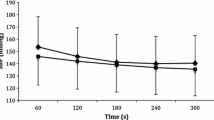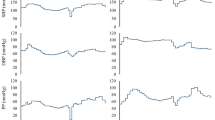Abstract
Regular physical exercise is known to reduce cardiovascular risk. We examined the effects of a single bout of moderate bicycle exercise on hemodynamic measures at rest and in response to the foot cold pressor (CP) and mental arithmetic (MA). Sedentary males and females (N=32) were tested twice, following 20 minutes of moderate exercise (exercise day) versus 20 minutes of quiet rest (control day). Although resting blood pressure was no lower 20 minutes after exercise relative to the same time point on the control day, diastolic blood pressure responses to CP (p=.05) and MA (p=.06) were attenuated on the exercise day. Furthermore, recovery from moderate exercise versus control rest was also associated with reduced vascular resistance index (VRI) at rest and during exposure to both stressors (p's ≤.02). VRI reductions were largest in subjects with elevated vascular tone on the control day and were accompanied by increases in heart rate throughout the postexercise period (p's≤.004) and higher cardiac index during exercise recovery and in response to CP (p's≤.05). Thus, the cardiovascular benefit of exercise may in part be due to reduced VRI and attenuated cardiovascular responses to stress during the acute postexercise period.
Similar content being viewed by others
References
Paffenbarger RS, Wing AL, Hyde RT: Physical activity as an index of heart attack risk in college alumni: XVI. Chronic disease in former college students.American Journal of Empidemiology. 1978,108: 161–175.
Paffenbarger RS, Hyde RT, Wing AL, Hsieh CC: Physical activity, all cause mortality, and longevity of college alumni.New England Journal of Medicine. 1986,314: 605–613.
Leon AS, Connet J, Jacobs DR, Rauramaa R: Leisure time physical activity levels and risk of coronary heart disease and death.Journal of the American Medical Association. 1987,258: 2388–2395.
Kenney MJ, Seals DR: Postexercise hypotension: Key features, mechanisms, and clinical significance.Hypertension. 1993,22: 653–664.
Brownley KB, West SG, Hinderliter AL, Light KC: Acute aerobic exercise reduces ambulatory blood pressure in borderline hypertensive men and women.American Journal of Hypertension. 1995.9: 200–206.
Cleroux J, Kouame N, Nadeau A, Coulombe D, LaCourciere Y: Baroreflex regulation of forearm vascular resistance after exercise in hypertensive and normotensive humans.American Journal of Physiology. 1992,263: H1523-H1531.
Floras JS, Wesche J: Haemodynamic contributions to post-exercise hypotension in young adults with hypertension and rapid resting heart rates.Journal of Human Hypertension. 1992,6: 265–269.
Hannum SM, Kasch FW: Acute postexercise blood pressure response of hypertensive and normotensive men.Scandinavian Journal of Sports Science. 1981,3: 11–15.
Wilcox RG, Bennett T, Brown AM, MacDonald IA: Is exercise good for high blood pressure?British Medical Journal. 1982,285: 767–769.
Kaufman FL, Hughson RL, Shaman JP: Effect of exercise on recovery blood pressure in normotensive and hypertensive subjects.Medicine and Science in Sports and Exercise. 1987,19: 17–20.
Bennett T, Wilcox RG, MacDonald IA: Post-exercise reduction of blood pressure in hypertensive men is not due to acute impairment of baroreflex function.Clinical Science. 1984,67: 97–103.
Perronet F, Massicotte D, Paquet J, Brisson G, de Champlain J: Blood pressure and plasma catecholamine responses to various challenges during exercise recovery in man.European Journal of Applied Physiology. 1989,58: 551–555.
Rejeski WJ, Thompson A, Brubaker PH, Miller HS: Acute exercise: Buffering psychosocial stress responses in women.Health Psychology. 1992,11: 355–362.
Roy M, Steptoe A: The inhibition of cardiovascular responses to mental stress following aerobic exercise.Psychophysiology. 1991,28: 689–700.
Cleroux J, Kouame N, Nadeau A, Coulombe D, LaCourciere Y: Aftereffects of exercise on regional and systemic hemodynamics in hypertension.Hypertension. 1992,19: 183–191.
Coats AJS, Conway J, Isea JE, et al: Systemic and forearm vascular resistance changes after upright bicycle exercise in man.Journal of Physiology. 1989,413: 289–298.
Piepoli M, Coats AJS, Adamopoulos S, et al: Persistent peripheral vasodilatation and sympathetic activity in hypotension after maximal exercise.Journal of Applied Physiology. 1993,75: 1807–1814.
Hara K, Floras JS: Influence of naloxone on muscle sympathetic nerve activity, systemic and calf hemodynamics and ambulatory blood pressure after exercise in mild essential hypertension.Journal of Hypertension. 1994,13: 447–461.
Rueckert PA, Slane PR, Hanson P: Hemodynamics of acute post exercise blood pressure decline in hypertensive subjects (Abstract).American Journal of Hypertension. 1993,6: 31A.
Piepoli M, Isea JE, Pannarale G, et al: Load dependence of changes in forearm and peripheral vascular resistance after acute leg exercise in man.Journal of Physiology. 1994,478: 357–362.
Casiglia E, Palatini P, Bongiovi S, et al: Haemodynamics of recovery after strenuous exercise in physically trained hypertensive and normotensive subjects.Clinical Science. 1994,86: 27–34.
Kilgour RD, Gariepy P, Rehel R: Cardiovascular responses during recovery from exercise and thermal stress.Aviation, Space, and Environmental Medicine. 1993,64: 224–229.
Paulev PE, Jordal R, Kristensen O, Ladfoged J: Therapeutic effect of exercise on hypertension.European Journal of Applied Physiology. 1984,53: 180–185.
Hagberg JM, Montain SJ, Martin WM: Blood pressure and hemodynamic responses after exercise in older hypertensives.Journal of Applied Physiology. 1987,63: 270–276.
Brown SP, Li H, Chitwood LF, Anderson ER, Boatwright D: Blood pressure, hemodynamics, and thermal responses after cycling exercise.Journal of Applied Physiology. 1993,75: 240–245.
Light KC, Sherwood A, Turner JR: High cardiovascular reactivity to stress: A predictor of later hypertension development. In Turner JR, Sherwood A, Light KC (eds),Individual Differences In Cardiovascular Response to Stress. New York: Plenum Press, 1992, 281–292.
Steptoe A, Kearsley N, Walters N: Cardiovascular activity during mental stress following vigorous exercise in sportsmen and inactive men.Psychophysiology. 1993,30: 245–252.
Southard DR, Hemesath SM, Humphrey R, Herbert WG: Effects of acute aerobic exercise on cardiovascular reactivity to stress in healthy untrained males (Abstract).Society of Behavioral Medicine Abstracts. 1992, 70.
Fillingim RB, Roth DL, and Cook EW: The effects of aerobic exercise on cardiovascular, facial EMG, and self-report responses to emotional imagery.Psychosomatic Medicine. 1992,54: 109–120.
Boone JB, Probst MM, Rogers MW, Berger R: Postexercise hypotension reduces cardiovascular responses to stress.Journal of Hypertension. 1993,11: 449–453.
Rejeski WJ, Gregg E, Thompson A, Berry M: The effects of varying doses of acute aerobic exercise on psychophysiological stress response in highly trained cyclists.Journal of Sport and Exercise Psychology. 1991,13: 188–199.
Floras JS, Sinkey CA, Aylward PE, et al: Postexercise hypotension and sympathoinhibition in borderline hypertensive men.Hypertension. 1989,14: 28–35.
Roth DL: Acute emotional and psychophysiological effects of aerobic exercise.Psychophysiology. 1989,26: 593–602.
Blanchard EM, Martin JE, Dubbert PM: Exercise as a treatment for hypertension. In Goldstein A, Krasner L, Garfield SL (eds),Non-Drug Treatments for Essential Hypertension. New York: Pergamon Press, 1988, 107–157.
National Heart, Lung, and Blood Institute:The Fifth Report of the Joint National Committee on Detection, Evaluation, and Treatment of High Blood Pressure, NIH Publication No. 93-1088. Washington, DC: U.S. Government Printing Office, 1993, 3–5.
O'Brien E, Murphy J, Tyndall A, et al: Twenty-four-hour ambulatory blood pressure in men and women aged 17 to 80 years: The Allied Irish Bank Study.Journal of Hypertension. 1991,9: 355–360.
Sherwood A, Allen MT, Fahrenberg J, et al: Committee Report: Methodological guidelines for impedance cardiography.Psychophysiology. 1990,27: 1–23.
Kubicek WG, Karnegis JN, Patterson RP, Wisoe DA, Mattson RH: Developmental and evaluation of an impedance cardiograph system.Aerospace Medicine. 1966,37: 1208–1212.
Gronwall DMA: Paced auditory serial-addition task: A measure of recovery from concussion.Perceptual and Motor Skills. 1977,44: 367–373.
Boone JB, Levine M, Flynn MG, et al: Opioid receptor modulation of postexercise hypotension.Medicine and Science in Sports and Exercise. 1992,24: 1108–1113.
Hagberg JM, Hickson RC, McLane JA, Ehsan AA, Winder WW: Disappearance of norepinephrine from the circulation following strenuous exercise.Journal of Applied Physiology. 1979,47: 1311–1314.
Valbo AB, Hagbarth KE, Torebjork HE, Wallin BG: Somatosensory, proprioreceptive, and sympathetic activity in human peripheral nerves.Physiology Review. 1979,58: 919–957.
Daskalopoulos DA, Shepherd JT, Walgerbach SC: Cardiopulmonary reflexes and blood pressure in exercising sinaortic-denervated dogs.Journal of Applied Physiology. 1984,57: 1417–1421.
Howard MG, DiCarlo SE: Reduced vascular responsiveness after a single bout of dynamic exercise in the conscious rabbit.Journal of Applied Physiology. 1992,73: 2662–2667.
Howard MG, DiCarlo SE, Stallone JN: Acute exercise attenuates phenylephrine-induced contraction of rabbit isolated aortic rings.Medicine and Science in Sports and Exercise. 1992,24: 1102–1107.
Light KC, Turner JR, Hinderliter AL, Sherwood A: Race and gender comparisons: Hemodynamic responses to a series of stressors.Health Psychology, 1993,12: 354–365.
Brownley KB: Acute aerobic exercise and social support buffer cardiovascular responses to stress: An examination of race differences in underlying physiological and psychosocial mechanisms. Unpublished doctoral dissertation, University of North Carolina at Chapel Hill, 1996.
Menkes MS, Matthews KA, Krantz DS, et al: Cardiovascular reactivity to the cold pressor test as a predictor of hypertension.Hypertension. 1989,14: 524–530.
Kasagi F, Akahoshi M, Shimoaka K: Relation between cold pressor test and development of hypertension based on 28-year follow-up.Hypertension. 1995,25: 71–76.
Girdler SG, Sherwood A, Brownley KB, et al: Cardiovascular stress responses predict ambulatory blood pressure ten years later (Abstract).International Congress of Behavioral Medicine Supplement. 1996, s135.
Hinderliter AL, Light KC, Girdler SG, Sherwood A: Blood pressure responses to stress: Relation to left ventricular structure and function.Annals of Behavioral Medicine. 1996,18: 61–66.
Levy D, Garrison RJ, Savage DD, Kannel WB, Castelli WP: Prognostic implications of echocardiographically determined left ventricular mass in the Framingham heart study.New England Journal of Medicine. 1990,322: 1561–1566.
Koren MJ, Devereux RB, Casale PN, Savage DD, Laragh JH: Relation of left ventricular mass and geometry to morbidity and mortality in men and women with essential hypertension.Annals of Internal Medicine. 1991,14: 345–352.
Devereaux RB: Hypertensive cardiac hypertrophy: Pathophysiological and clinical characteristics. In Laragh JH, Brenner BM (eds),Hypertension: Pathophysiology, Diagnosis, and Management. New York: Raven Press, 1990, 359–377.
Gibbons GH, Dzau VJ: The emerging concept of vascular remodeling.New England Journal of Medicine, 1994,330: 1431–1438.
Graettinger WF, Longfellow JV, Klein RC, Weber MA: Diastolic blood pressure and left ventricular filling.American Journal of Hypertension. 1988,1: 100S-102S.
Author information
Authors and Affiliations
Additional information
Preparation of this manuscript was supported in part by National Institute of Health grants R01 HL31533, HL50778, RR00046, MH09855, MH11079, and MH10708.
About this article
Cite this article
West, S.G., Brownley, K.A. & Light, K.C. Postexercise vasodilatation reduces diastolic blood pressure responses to stress. ann. behav. med. 20, 77–83 (1998). https://doi.org/10.1007/BF02884452
Issue Date:
DOI: https://doi.org/10.1007/BF02884452




